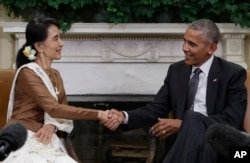The United States pulled its ambassador from Myanmar in 1990 after the military refused to cede power to a civilian government. U.S. sanctions were imposed in 1997 and have been in place in some form ever since. Here is a look at those sanctions:
What prompted the sanctions?
The diplomatic rift between Burma and the United States began after mass protests over economic mismanagement in 1988 led the military to suppress the protests and launch a coup. In September of that year, the military established the State Law and Order Restoration Council (SLORC), and the following year changed the country's official name to Myanmar.
As the SLORC had promised, on May 27, 1990, Burma held general elections for the first time since 1960. Political activist Aung San Suu Kyi's National League for Democracy (NLD) won 392 of the 492 parliamentary seats. But the SLORC refused to recognize the election results.
The move prompted the U.S. to cut off economic aid and military assistance to Myanmar and downgrade diplomatic relations.
What were the sanctions?
In 1997, the U.S. government prohibited new investment in Myanmar by U.S. persons or entities. A number of U.S. companies exited the Burma market, even prior to the imposition of sanctions, due to a worsening business climate and mounting criticism from human rights groups, consumers and shareholders.
In 2003, a government-sponsored mob attacked an NLD convoy in central Myanmar and killed at least 70 people. U.S. President George W. Bush imposed new sanctions, banning the import of products from Myanmar and the export of financial services, placing a freeze on the assets of certain Burmese financial institutions, and extending visa restrictions on Burmese officials.
In 2007-2008, Bush announced a new Executive Order expanding the authority to block assets to individuals who are responsible for human rights abuses and public corruption, as well as those who provide material and financial support to the regime.
In addition, due to its particularly severe violations of religious freedom, the United States designated Myanmar a Country of Particular Concern (CPC) under the International Religious Freedom Act. Myanmar also is designated a Tier 3 Country in the Trafficking in Persons Report for its use of forced labor, and is subject to additional sanctions as a result.
What has changed?
In late 2011, Hillary Clinton became the first U.S. secretary of state to visit Myanmar since 1955. Clinton met with President Thein Sein, the former general whose government had begun to undertake a series of political reforms. She also met with democracy activist Aung San Suu Kyi in Yangon.
In January 2012, Clinton announced the U.S. would exchange ambassadors with Myanmar after the release of several political prisoners. In July, Derek Mitchell became the first U.S. ambassador to Myanmar in 22 years. Washington also began easing sanctions after the military junta began ceding power to civilian rule. Since then, Myanmar has taken steady steps toward political liberalization that eventually led to elections in November of last year, which Aung San Suu Kyi's party won.
What is next?
On Wednesday, President Barack Obama said the United States is prepared to lift economic sanctions on Myanmar. When asked about the timeline for lifting the remaining sanctions, Obama replied, "Soon."
Officials say "some" U.S. sanctions will remain in place for the time being, but it is not yet clear which ones.











